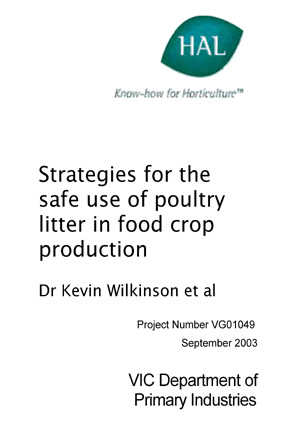|
For generations, vegetable growers have enjoyed the many advantages that poultry litter has to offer including
- its soil-conditioning ability
- slow and fast rate of nutrient release and trace elements
- low cost and ease of application
However, in July 2001, the use of poultry litter in vegetable production was a contentious issue due to concerns about food safety and the possibility of litter contaminating crops.
It was known that litter contains bacteria that have the potential to cause human illness, such as Salmonella and contamination of lettuce with manure had been implicated as the cause of bacteriological food poisoning outbreaks.
Furthermore, glasshouse trials at the Department of Primary Industries, Victoria had shown that slight damage to vegetable plants could allow Escherichia coli to persist in the plant for at least three weeks.
It was not known at the time whether these bacteria could also survive on field grown crops.
While many growers were being discouraged from using poultry litter, the risk to human health was largely unknown.
The future of this practice was thought to be uncertain unless the risks to the community were known and strategies for reducing the risk were developed.
Authors
|
Kevin Wilkinson
|
Dean Harapas
|
Emily Tee
|
Bruce Tomkins
|
Robert Premier
|


Conclusions
Bacteriological testing on all 7 farms showed low E. coli counts and no Campylobacter or pathogenic Salmonella on any crops at harvest.
Litter deliveries were variable in E. coli counts and the presence of Salmonella .
No Campylobacter or Listeria was found in litter deliveries either.
Non-pathogenic Salmonella was found on a coriander crop that could be traced back to fresh litter that had been side-dressed 18 days prior to harvest.
The coriander field was only 50 metres away from the poultry litter stockpile. Contamination via rain, wind, turbulence from vehicles passing by and movement of litter for treatment of other fields may also have occurred.
Field and glasshouse trials showed that E. coli could persist longer on damaged Cos lettuce leaves than undamaged leaves when damage and contamination occurred close together.
If contamination was delayed until 3 days after the damage occurred, the survival of E.coli (measured three days after application) was similar to that of undamaged plants.
This result indicates that farm practices that may contaminate plants, such as side dressing with fresh litter, should not be done after practices or weather conditions that could cause minor injury to the plants.
Aging for 12 weeks and turning the heap was found to marginally improve the hygienic condition of poultry litter.
The process of aging occurs under sub-optimal conditions resulting in low rates of decomposition. Turning the heap is ineffective under these conditions because the progress of stabilisation is too slow to prevent continual re-contamination and persistence of pathogens on the outside edge of the pile.
An aging process is not equivalent to controlled composting which is characterised by rapid rates of decomposition achieved through stringent, documented process control.
Whilst controlled composting will undoubtedly produce the safest product from poultry litter, our results suggest that it is not necessary to recommend it for all applications.
However, in the medium term, poultry litter recycling is likely to come under closer state environment protection regulation to bring it in line with other organic recycling activities (e.g. green waste composting sites).
The likely result of this will be the establishment of controlled composting facilities for poultry litter.
To ensure that poultry litter will be a viable option for vegetable growers in the medium term, further studies are needed to develop poultry litter processing guidelines that meet QA and environment protection guidelines without causing detriment to its value as a fertiliser.
As composting will increase the cost of poultry litter, these studies are urgently needed to minimise the cost of processing and maximise the return for the grower.
Recommendations
- To avoid the risk of pathogens contaminating and persisting on crops, it is recommended that fresh litter should not be used as a side-dressing. Only fully composted poultry litter should be used for side-dressing.
- Whilst it has not been possible to determine the minimum distance required to prevent cross contamination, storage of litter as far away as possible from mature crops is recommended.
- Aged litter should not be regarded as equivalent to a fully composted product. Where fully composted litter is appropriate or desired, the supplier should demonstrate that it was produced under documented process control following established best practice and HACCP guidelines (e.g. AS 4454-1999.
- Develop processing guidelines for poultry litter that meet QA and environment protection guidelines without causing detriment to its value as a fertiliser.
Acknowlegements:
Peter Franz, Department of Primary Industries (Victoria), Knoxfield, for providing statistical advice for the persistence of enteric bacteria on leafy vegetable trials.
Dr Graham Hepworth, from the Statistical Consulting Centre at The University of Melbourne, for experimental design assistance, analysing data and providing statistical advice with regards to the persistence of enteric bacteria in poultry litter trials.
Francha Horlock, Janet Tragenza (Department of Primary Industries (Victoria), Knoxfield) and Iphie Papapetrou (Box Hill Institute, Victoria) for providing technical advice and assistance.
Agnes Tan and Nela Subasinghe from The Microbiological Diagnostic Unit, Department of Microbiology and Immunology at The University of Melbourne for microbial diagnostic advice and services.
Dr Barry Macauley from the Department of Microbiology at Latrobe University provided valuable assistance in the interpretation of the experiments examining the reduction and persistence of enteric bacteria during aging of poultry litter.
This work was funded by: Horticulture Australia Pty Ltd, Department of Primary Industries (Victoria) and the Australian Vegetable Growers through the AUSVEG levy with voluntary contributions from: VegFed (NZ), CL & AK Warlan, Lightowler Fowl Manure Pty Ltd, TD & EC Ould Pty Ltd
|

